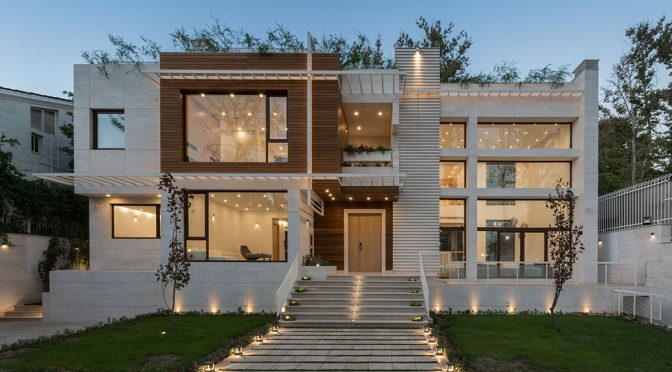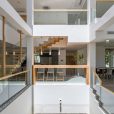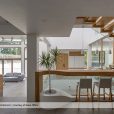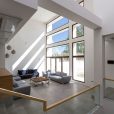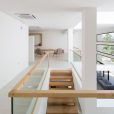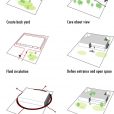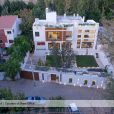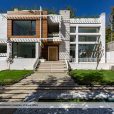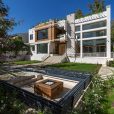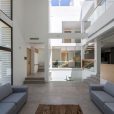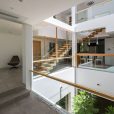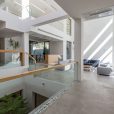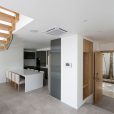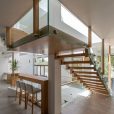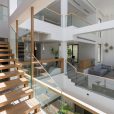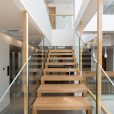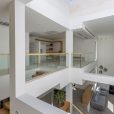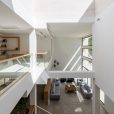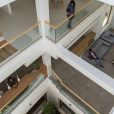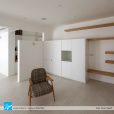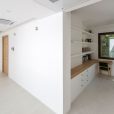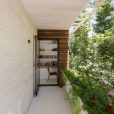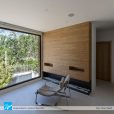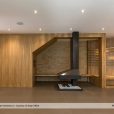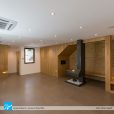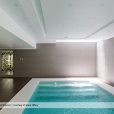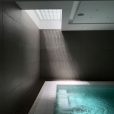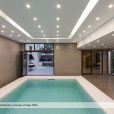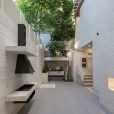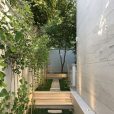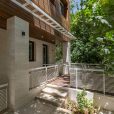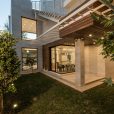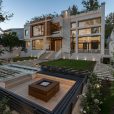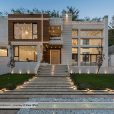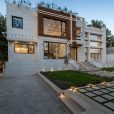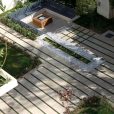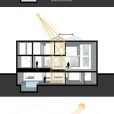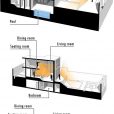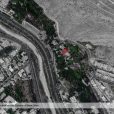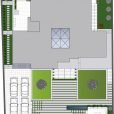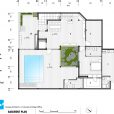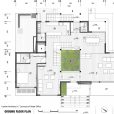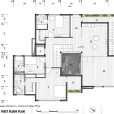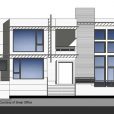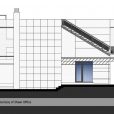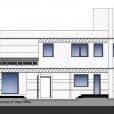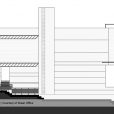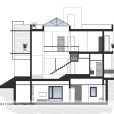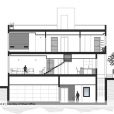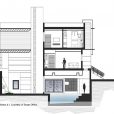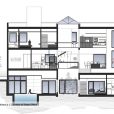خانه شماره ۳
دفتر معماری شار (احمد قدسیمنش)
موقعیت: شیراز، ایران
تاریخ: ۱۳۹۶
مساحت: ۶۵۰ مترمربع
وضعیت: ساختهشده
کارفرما: توانا
همکار طراحی: مریم ناظمالبکا
طراح سهبعدی: پریسا پناهی
سازه: علی رادمان
تاسیسات مکانیکی: کریم روزیطلب
تاسیسات الکتریکی: شرکت یاشا الکتریک
تیم اجرایی: رضا فتحی، محمدرضا احمدی
مصنوعات چوبی: معین نیکویی
گرافیک: سمانه زارع، نسترن جنابعلی
عکس: پرهام تقیاف، دانش دانشجو
بلوار چمران، بلواری است سرسبز در محدوده میانی شهر شیراز که با باغهای قصردشت احاطه شده است. در یکی از کوچههای این بلوار، یک فرعی به نام «بهشت» وجود دارد که یکی از زیباترین کوچههای آن منطقه است، کوچهای که اکثر باغهای آن، به صورت بکر و طبیعی باقی مانده و فقط شش پلاک مجوز ساخت «خانهباغ» داشتهاند؛ زمین پروژه با مساحت ۷۵۰ مترمربع، یکی از این شش پلاک بود. متاسفانه، از انبوه درختان موجود در باغ، به علت عدم رسیدگی مالک قبلی و قطع آب روان موجود، فقط تعداد کمی درخت باقی مانده بود. از اینرو، در جانمایی اولیه توده بنا، هدف اصلی طراحی، حفظ کلیه درختان موجود، به هر قیمتی بود. در نتیجه، حجم کلی بنا طوری قرار گرفت که هیچ درختی از مجموعه درختان باغ قطع نشود یا در طی مراحل اجرا، آسیب نبیند.
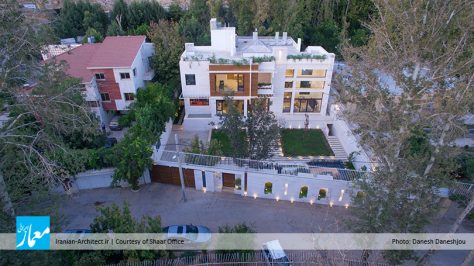
مالک پروژه، خانوادهای است کمجمعیت و در عین حال، پررفتوآمد. با توجه به صحبتهای طولانی و اولیه با مالک و نیازهای متنوع آنها، برنامه فیزیکی بسیار پرحجمی آماده شد که با توجه به آن، ایجاد تنوع فضایی، چه در فضاهای بسته و چه در فضاهای باز، در اولویت طراحی قرار گرفت. بر مبنای جلسات متعدد با مالک، خواستههای متعدد فضایی و محدودیت ارتفاعی ۸.۵ متر، ساختمان در سه طبقه زیرزمین، همکف و اول طراحی شد و سازماندهی اصلی پروژه به این ترتیب انجام شد که در زیرزمین، استخر، یک اتاق خواب، سالنی جهت پذیرایی یا میهمانی دورهمی، یک انبار، و اتاق سرایداری (با دسترسی از حیاط) قرار گرفت، در طبقه همکف، اتاق میهمان، آشپزخانه، نهارخوری، سالن نشیمن و سالن اصلی، و در طبقه اول، سه اتاق خواب، یک نشیمن خصوصی و فضایی کوچک برای کار طراحی شد.
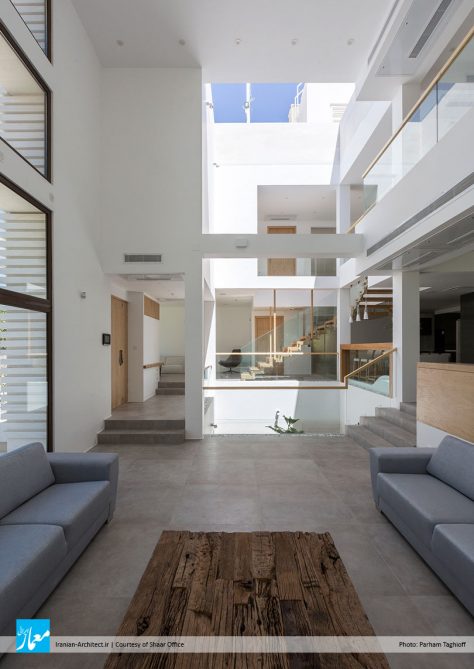
چالش اصلی این پروژه، در تفاوت با دیگر پروژههای تکواحدی ارجاعشده به دفتر ما، این بود که استفاده از این خانه، برای تفریحات آخر هفته یا تعطیلات نبود، بلکه سکونت کامل در آن صورت میگرفت. از طرف دیگر، تفاوتهای فضای سکونت تکواحدی ویلایی با فضای سکونت آپارتمانی، برای ما بسیار حائز اهمیت و قابل تامل بود. از اینرو، از مهمترین ایدههای اصلی پروژه که بعد از ایجاد تنوع فضایی، نقش پررنگی را در طراحی ایفا کرد، ایجاد فضاهایی با حداکثر نور طبیعی و همچنین، امکان دیدهای متفاوت از فضایی به فضای دیگر، و از درون به بیرون، و از بیرون به درون بود.
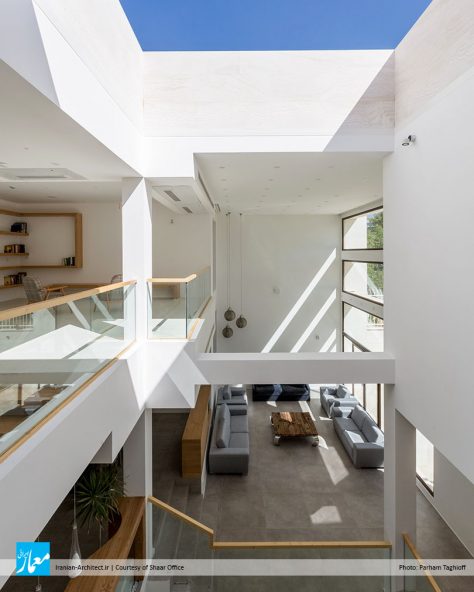
در ابتدای کار، با طراحی یک فضای تهی مرکزی، نور به میانه بنا که قاعدتا مکانی با کمترین نورگیری بود، هدایت شد و بستری نیز برای ایجاد یک فضای سبز داخلی به وجود آمد. این فضای خالی مرکزی، به ما کمک کرد که بتوانیم تنوع و تعدد فضایی مورد نظر خود را بهتر و متمرکزتر ایجاد کنیم. از طرف دیگر، دیدهایی متنوع از فضاها به یکدیگر ایجاد شد که به تنوع کیفیت فضایی و همچنین، ایجاد سیالیت فضایی بین نقاط مختلف مجموعه کمک کرد. سقف این فضا نیز متحرک طراحی شد که در مواقع مورد نیاز، بتوان با بازکردن آن، هم به تهویه طبیعی هوای داخل کمک کرد و هم حس و حال فضای باز بیرون و هوای مطبوع باغهای اطراف، به داخل خانه هدایت شود.
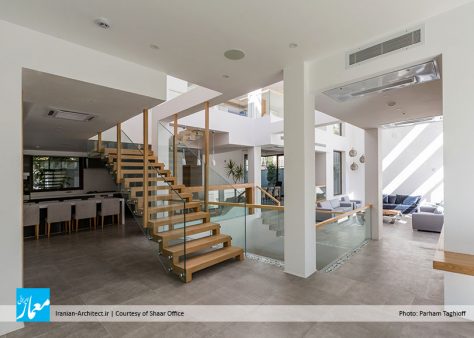
برخلاف رویه معمول سایر پروژهها، راهپله به صورت مرکزی طراحی نشد و ارتباط عمودی بین هر طبقه با طبقه دیگر، از مکانی متفاوت و با تجربه بصری و کیفیت فضایی متفاوت، اتفاق افتاد. البته یک آسانسور هم برای ارتباط عمودی بین طبقات تعبیه شد. در طراحی داخلی نیز سعی شد با یک طراحی کمینه، هم به نیازها پاسخ داده شود و هم مزاحمتهای بصری کمتری اتفاق بیفتد. در انتخاب رنگ و بافت عناصر هم، به گونهای عمل شد که با توجه به تعدد فضاها، شلوغیهای بصری معمول به صفر برسد و فضایی مطلوب با رنگ سفید و چوب طبیعی، به وجود آید.

در طراحی حیاط، رفع مشرفیت از همسایهها و همچنین، تامین نور زیرزمین، مهمترین دغدغه طراحی بود، از اینرو، در حیاط پشت که درختان قدیمی، فضایی بسیار دلنواز را فراهم کرده بودند، یک صبحانهخوری با دسترسی مستقیم به آشپزخانه، به گونهای که هیچ دیدی از اطراف به آن وجود نداشته باشد، طراحی شد. همچنین، در قسمت پشتی ساختمان و در ارتباط مستقیم با استخر، گودالباغچهای طراحی شد که هم با کمک فضای نورگیر داخلی، از یک طرف، و نورگیر سقفی استخر، از طرف دیگر، به تامین نور زیرزمین کمک کند و هم فضایی باشد که استفادهکنندگان از استخر بتوانند آزادانه از فضای باز بیرون لذت ببرند. در حیاط جلو نیز، بیشتر به ایجاد فضای سبز و دسترسیهای متفاوت از بیرون به داخل اهمیت داده شد و همچنین، فضایی به نشستنهای عصرگاهی اختصاص داده شد که آتشدانی نیز در وسط آن قرار دارد.
House No. 03
Shaar Office (Ahmad Ghodsimanesh)
Location: Shiraz, Iran
Date: 2017
Area: 650 sqm
Status: Completed
Client: Tavana
Design Associate: Maryam Nazemolboka
3D Modeling: Parisa Panahi
Structural Consultant: Ali Radman
Mechanical Consultant: Karim Rouzitalab
Electrical Consultant: Yasha Electric Co.
Construction Team: Reza Fathi, Mohamadreza Ahmadi
Woodwork: Moein Nikoei
Graphic: Samaneh Zarei, Nastaran Jenabali
Photo: Parham Taghioff, Danesh Daneshjou
Chamran green boulevard, surrounded by Qasrodasht gardens, is situated in the middle of Shiraz city. The site plan of the project is located in one of the most beautiful side-streets of the region, called Behesht (means paradise). In case of all gardens in the alley remained intact, just six spots were permitted to be constructed as garden house. Among these six spots, we had one with 750 square meters. Unfortunately, there were just few trees remaining in the site, due the lack of effort by the previous landlord and the cut off the water supply. During the positioning of the building in the site, our focus was to maintain the existing trees; harmonization of the building with the landscape surrounding was the prominent vision of the project.
The owner has a small family, but they are usually hosts, due to the close ties with their friends and relatives. We organized an initial meeting with the family members which resulted in creating a physical program on the basis of their various needs. So, the priority of the design is specified as to create a high variety of interior and exterior spaces. The building designed in three levels, basement, ground floor and first floor, with regards to the building height limitation to 8.5 meters and the various spaces the client specified. The placement plan of the project is as follows: on the basement floor, there is a pool, one master bedroom, living room for catering, warehouse and a caretaker’s room (with yard access), and on the ground floor, there is a guest room, kitchen, dining room, sitting room and a main living room, and first floor of the building contains three bedrooms, a private sitting room and a small work-space.
Most of the single-unit house projects we have done before, were usually designed as a vacation house, but “House No. 3” was built with the intent of comfortable human habitation. In addition to creating spatial diversity, we placed windows and openings; so that, natural light provides effective internal light, during the day. Furthermore, the main consideration in this design, was to connecting both the interior and exterior in an open plan while preserving the visual connectivity. A central skylight provides additional light to the dark spaces while permitting a central green space within the core of the house. A retractable roof was considered for the central courtyard, for natural ventilation in the interior and to allow the efficient airflow throughout the building.
The floors are connected with one elevator, while the stairs wrap around the void creating magnificent views throughout the house; it means vertical connection between floors, take place in different spots by distinct visual experience and spatial quality. By adding natural woods and white color, we created a sense of warmth, while achieving a classic look that’s cozy and inviting. We tried minimal designing while responding to needs, and fewer visual disturbances happen. The color and texture of the elements were selected in the way despite the multiplicity of spaces.
Two important concerns throughout the landscape design, were eliminating the neighborhood’s sight and supplying the underground light. Hence, a breakfast space with direct access to the kitchen and no visibility from surrounding, is considered in the backyard, accompanied with old trees that provide a pleasant atmosphere. A Sunken courtyard is located at the back of the building, with direct access to the pool, providing some light for the basement and a pleasant green space in front of the pool, for the residents. The Pool also has a ceiling light to create an eye-catching play of light and shadow on the water. Green spaces and easy access to the entrance of the house, was considered while designing the landscape of the front yard; here, a cozy sitting place is designed around a fire pit, creating an outdoor gathering space.

